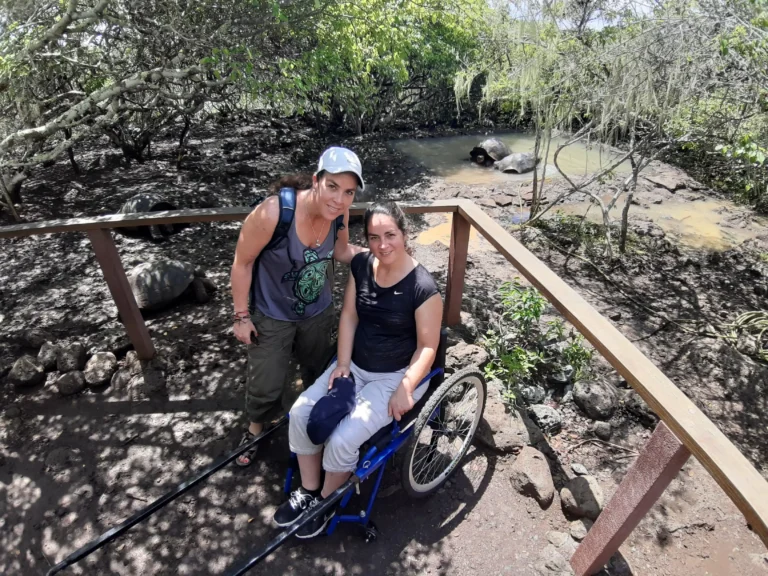
Listen to this Article
“Start by doing what’s necessary; then do what’s possible; and suddenly you are doing the impossible.” – Francis of Assisi
I believe this phrase fits perfectly for a person like me, who has to learn to live with a disability. Almost five years ago, I had a horse accident that left me with a paraplegia from my waist down, which means I cannot feel or move any part of my body below my ribs. In a matter of seconds, my life had an irreversible turnabout, which would not only bring difficulties, but several life lessons and blessings as well. I feel blessed by the fact that I am still alive, with full use of my mind, and am able to share my life with my children, who at the time of the accident were aged one and three. I have felt the love and support of family and friends more intensely than ever. And I have proven myself to be stronger than I ever imagined possible. Perhaps my new life has brought more blessings than difficulties. But, until recently, there was something that really upset me, and I simply decided not to give it much thought: how challenging it would be for me to travel.
ME AND TRAVELLING
I love to travel. I loved to work in the travel field. I traveled for work, and worked so I could travel. Besides being passionate about travelling, I´ve always been passionate about promoting my country as a unique destination. I wrote travel articles for over 15 years for our family business.
As a journalist, I travelled countless times throughout my wonderful country. I was invited on several press trips. I also worked for a public relations office, where I got to organize and accompany national and international journalists on press trips throughout Ecuador. I loved to share all the wonders I discovered in my own country both with our magazine readers as well as with journalists, family and friends.
BUT NOW THAT I´M IN A WHEELCHAIR, GALAPAGOS . . . ACCESSIBLE? NO WAY!
Now more and more travellers are able to enjoy Galapagos, this “living laboratory of evolution”. But… accessible for all? Until recently, I was almost sure not. I quit working for the magazine after my accident. With my new life in a wheelchair… adventure travel? The Galapagos? No way! I comforted myself by thinking “I’m glad I got to do so much of it when I could.” However, it really upset me to think I would not be able to continue enjoying these adventures. And even more so to think I would not be able to share my passion for the outdoors with my kids.
Thanks to Latin America for All . . . I did it again!! In a different way of course, but it happened! Rolling through those trails I had once left my footsteps on felt like magic. Moreover, I was able to once again enjoy one of my favourite activities: snorkelling. Next time I’ll make sure to go scuba diving! We also did kayaking, sightseeing, swimming and more… A dream come true!
I felt immensely thankful to life. And of course, to Latin America for All.
MY GALAPAGOS EXPERIENCE IN A WHEELCHAIR
I travelled to San Cristóbal Island, and stayed in the town of Puerto Baquerizo Moreno. The highlight of this town is the main street with a boardwalk next to the sea, and from which, at a point, you can spot several sea lions (and unfortunately smell them as well).
The tour operation at Galapagos is outstanding! Their most remarkable asset is their staff! Guides and the support people in charge of logistics were extremely helpful. They would go beyond their responsibilities in order to make our trip pleasant. You could definitely tell they enjoy their job, and their passion for their home island is contagious!
The tours also include top notch equipment, special wheelchairs for the trails, beach wheelchairs, flotation devices to make snorkelling comfortable, wetsuits, and snorke-lling gear. Also worth mentioning is their flexibility to adapt to the needs of their passengers. The staff was respectful of the times we needed for certain activities. They invited us to participate in several activities, however, they never made us feel pressured, but rather confident in the fact that we were in excellent hands.
THE FOOD
I really enjoyed the food! Whenever I am at sea level, I like to eat fresh fish and seafood. And I found it delicious in San Cristóbal!
I believe the restaurants were carefully selected. Although some of them did not seem very good by just looking at the place, the food was quite tasty. The ones I liked the best were El Descanso Marinero, where I had delicious clamshells, and which had a folkloric marine decoration. Maui Resto Bar had a laid-back tropical ambiance with trees inside. Here I dined a superb prawns and we shared nice cocktails. Finally, the restaurant where we had lunch on the day of our visit to the highlands, Ottoy was located in a farm with a lush tropical vegetation and overlooking the highlands all the way to the sea. Here I had a fish dish served with rice, salad and a delicious natural fruit juice.
DAY BY DAY
Day 1: Arrival at hotel + Lunch + Briefing + Snorkel at Lobería Beach
Although the main purpose of this visit is to try the snorkelling equipment and find what suits your needs best, it is a great introduction to the Galapagos. This beach of white sand and clear sea, close to town, is inhabited by sea lions, the endemic marine iguanas, and a variety of marine birds. In the water, one can encounter some of the most common species of the Galapagos Marine Reserve, including sea turtles, rays, a variety of fish and, with some luck, spot white-fin sharks.
Day 2: Kayak + Interpretation Center + Tijeretas View Point
Kayaking around the bay was quite relaxing. We caught sight of several animals, both at the rocks on the shores, as well as on the boats that were anchored in the bay. We saw sea lions, marine iguanas, crabs, blue-footed boobies and other marine birds.
After lunch, we took a quick tour of the San Cristobal Interpretation Center to learn about Galapagos natural and cultural history, and the challenges for the future of the conservation of the archipelago.
Later we continued on a trail that guided us to Tijeretas View Point to admire the island from above.
Day 3: Giant tortoise breeding center + Highlands
After breakfast, we visited Cristobal´s Giant Tortoise breeding center, to admire the giants after whom the islands are named. The National Park has done a good job bringing up these tortoises and saving them from extinction, after they were almost completely vanished due to their use as a delicacy for buccaneer and pirates of the17th and 18th centuries. The Galapagos Tortoises also lost (and keep losing at a smaller rate) their eggs and hatchlings to introduced species such as pigs and dogs, and lost food due to competition with goats and cows. Today, the Giant Tortoise population is increasing, and several individuals have been released in their natural habitat. However, some subspecies are already extinct.
Then we continued our trip to the highlands, where we had lunch at a beautiful restaurant in lush gardens.
Day 4: Snorkeling at Kicker Rock + visit to Manglesito Beach
For me, this was the highlight of the whole visit to San Cristobal. Kicker Rock is a stunning tuff cone rising over 140 metres out of the ocean, a 45-minute boat ride from the town. Locals call it Leon Dormido (Sleeping Lion). Several marine birds live on Kicker Rock, including blue-footed boobies, gulls and frigate birds, but to appreciate the best of this visit, do not miss the snorkelling! Swimming at the edge and through the canal that divides this formation in two, the walls are covered with colourful algae and starfish. We spotted sea turtles, eagle rays, white-tip sharks and even hammerhead sharks! It sounds scary, but in fact, these animals seemed to not even notice our presence.
Moreover, we were so lucky on the day of our visit, that during our navigation, we were followed by several dolphins that swam and jumped around our boat for at least 10 minutes.
Later we had lunch at the boat, we went to the nearby beach of Manglesito to rest for a bit and enjoy the beautiful scenery. It is a beach of white sand and mangroves, thus the name Manglesito. You can also snorkel around if you’d like, or just rest on the beach after all the excitement of Kicker Rock.
Day 5: Return to Quito
